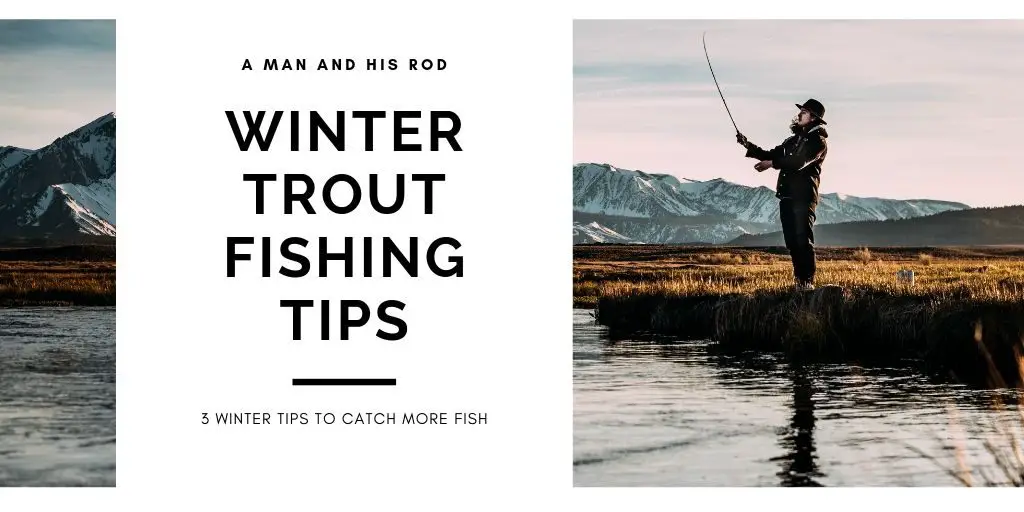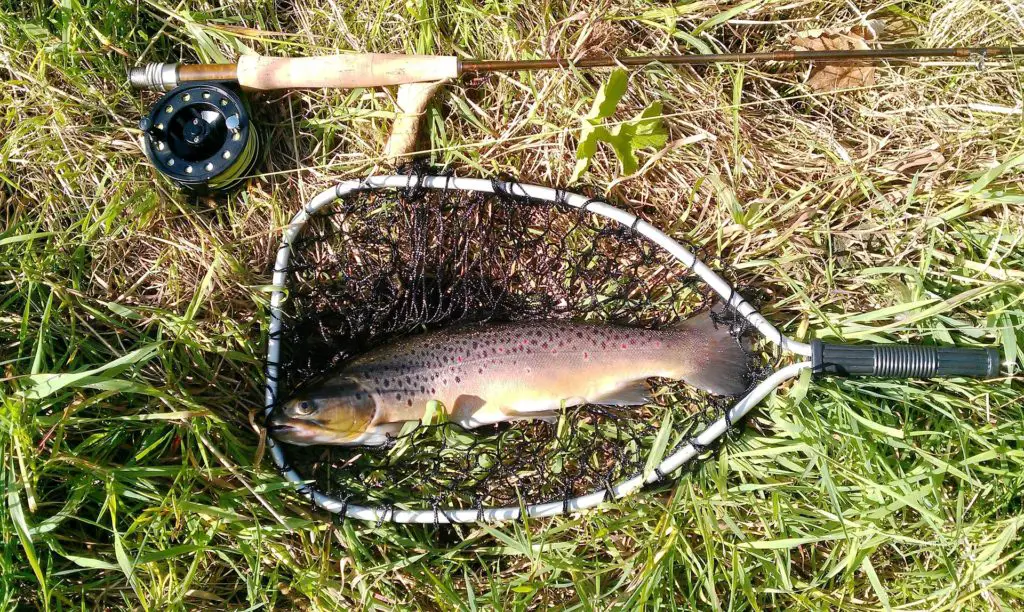Using a fishing float or bobber can be a very exciting and productive setup to fish. This type of fishing rig has many distinct advantages and only a few disadvantages. As we have discussed before in “Trout Fishing for Beginners“, trout feed on other fish, worms, insects, and crayfish, as well as plankton in order to survive. The truth is that fish feed at every level of the water column. Most fishermen only fish the bottom level of the water column abandoning two-thirds of the potential fishing area.
In this article, you will learn how to tap into that mostly un-fished potential and how to catch more fish using a fishing float or bobber.
This website is reader supported. Any purchases you make through links on this site earn us a commission at no additional cost to you. Thank you for your support!
Understanding the Basics of Bobber Fishing
Fishing with a bobber, also known as float fishing, is a popular angling technique that involves suspending bait at a desired depth using a floating device. This method allows anglers to present their bait at a specific level in the water column, increasing their chances of enticing fish to bite. Whether you’re targeting panfish, bass, trout, or even catfish, mastering the basics of bobber fishing is crucial. Let’s dive deeper into the key elements that make bobber fishing effective.
1. Selecting the Right Bobber
To start your bobber fishing adventure, it’s important to choose the right bobber for the job. Bobbers come in various shapes, sizes, and materials, each designed for specific fishing conditions and target species. Here are a few popular types of bobbers you can consider:
- Round Bobbers: These classic bobbers are round and attach to your fishing line with a spring-loaded clip. They are versatile and suitable for a wide range of fishing situations.
- Slip Bobbers: Slip bobbers offer the advantage of adjustable depth. They can slide along the fishing line, allowing you to fish at different depths easily.
- Pencil Bobbers: Long and slender, pencil bobbers are great for casting long distances and are commonly used in open-water fishing.
2. Choosing the Right Fishing Rod and Reel
Selecting the appropriate fishing rod and reel is essential for effective bobber fishing. Different species of fish and fishing conditions call for specific gear. Here are a few considerations to keep in mind:
- Rod Length: Longer rods, typically between 6 to 9 feet, provide better casting distance and control, while shorter rods offer greater precision in confined spaces.
- Rod Power and Action: The power of a rod refers to its strength and ability to handle heavy fish, while the action indicates the flexibility of the rod. Match the rod power and action to your target species and fishing technique.
- Reel Type: Spinning reels are commonly used for bobber fishing due to their versatility and ease of use. Choose a reel size that complements your rod and the fishing line you intend to use.
3. Selecting the Right Fishing Line
Choosing the right fishing line is crucial in bobber fishing. The line should be strong enough to handle the target species while also providing sensitivity to detect subtle bites. Consider the following options:
- Monofilament Line: Monofilament line is a popular choice for bobber fishing due to its versatility and affordability. It offers good knot strength and is less likely to tangle.
- Braided Line: Braided line is known for its exceptional strength and sensitivity. It has a smaller diameter, allowing for longer casts and increased line capacity on the reel.
- Fluorocarbon Line: Fluorocarbon line is virtually invisible
The Benefits of Using Bobbers for Fishing
Using bobbers for fishing offers several benefits that make it a popular choice among anglers. Here are some of the advantages:
- Bite Detection: One of the primary benefits of using bobbers is their ability to detect bites. When a fish takes the bait, the bobber will move or disappear beneath the water’s surface, providing a clear visual indication that a fish is interested in the bait. This makes it easier for anglers to know when to set the hook and increase their chances of successfully landing the fish.
- Depth Control: Bobbers allow anglers to easily control the depth at which their bait is presented. By adjusting the position of the bobber on the fishing line, anglers can suspend their bait at a specific depth in the water column where they believe the fish are actively feeding. This precision in-depth control increases the effectiveness of the presentation and can lead to more successful catches.
- Versatility: Bobbers are versatile fishing tools that can be used in various fishing environments and for different species of fish. Whether you’re fishing in a lake, river, or pond, bobbers can be adjusted to suit the specific conditions and target species. This adaptability makes bobber fishing a go-to technique for many anglers.
- Ease of Use: Bobbers are simple and easy to use, making them suitable for anglers of all skill levels, including beginners. Setting up a bobber rig is straightforward, and casting with a bobber is relatively easy compared to other fishing techniques. This accessibility makes bobber fishing a great option for those who are new to fishing or want a hassle-free angling experience.
- Increased Bait Presentation: By suspending the bait at a desired depth, bobbers allow for a more natural presentation. The bait remains in the strike zone for a longer period, increasing the chances of attracting fish. The stillness of the bait, aided by the buoyancy of the bobber, can be particularly enticing to fish that are looking for an easy meal.
- Minimal Tangles: When fishing in areas with vegetation or structures, using bobbers can help minimize tangles and snags. By keeping the bait and hook suspended above the potential obstructions, anglers can reduce the risk of getting their line caught and increase their fishing time.
Using bobbers for fishing provides anglers with bite detection, control over bait depth, versatility, ease of use, improved bait presentation, and reduced tangles. Whether you’re a novice angler or a seasoned pro, bobber fishing can be an effective and enjoyable technique to add to your angling arsenal.
What Types of Fish are Commonly Caught with Bobbers?
Bobbers are versatile tools that can be used to catch a wide range of fish species. While the specific fish that can be caught with bobbers may vary depending on the region and fishing environment, here are some common fish species that are often targeted using bobbers:
- Panfish: Panfish such as bluegill, sunfish, crappie, and perch are frequently caught using bobbers. These species are often found in freshwater lakes, ponds, and slow-moving rivers, and they readily take bait suspended at the desired depth.
- Bass: Largemouth bass and smallmouth bass can be successfully targeted with bobbers. These predatory fish are known to strike at bait presented near the surface, making them prime candidates for bobber fishing. Casting near structure, weed beds, or along the shoreline can increase your chances of enticing bass with a bobber setup.
- Trout: Trout, including rainbow trout, brown trout, and brook trout, are commonly pursued using bobbers. These fish often feed near the water’s surface or in the top few feet of the water column, making them receptive to bait suspended by bobbers. Bobber fishing is particularly effective when targeting trout in lakes, rivers, or stocked ponds.
- Catfish: While bobber fishing may not be the most common method for catching catfish, it can still be effective, especially when targeting smaller catfish species. Using bobbers with bait such as worms, cut bait, or stink bait can entice catfish to bite. Fishing in areas with cover, such as submerged logs or vegetation, can increase your chances of success.
- Crappie: Crappie, a popular game fish, are often caught using bobbers. These fish tend to suspend at various depths in the water column, and using a bobber allows you to present bait at their level. Crappie are commonly found in freshwater lakes, ponds, and rivers, and are known for their schooling behavior.
- Pike: Northern pike, known for their aggressive feeding habits, can also be caught using bobbers. These predatory fish are attracted to movement and vibrations in the water, making a bobber setup with live bait or artificial lures an enticing option. Fishing near weed beds or areas with structure can increase your chances of hooking a pike.
- Walleye: Walleye, known for their nocturnal feeding habits, can be targeted with bobbers during low-light conditions or in the early morning and late evening. Walleye are often found near submerged structures or drop-offs, and a bobber rig with live bait, such as minnows or leeches, can be an effective presentation.
These are just a few examples of the fish species commonly caught with bobbers. However, it’s important to research and understand the local fishing regulations, target species, and preferred bait in your specific fishing location. This will help you make informed decisions when setting up your bobber fishing rig and increase your chances of a successful angling experience.
Bait for Fishing Floats and Bobbers
Using bait when fishing with floats and bobbers is ideal. These baits are natural and are among the most enticing for fish. Presenting a more natural meal will result in more bites and more fish.
The best bait for bobber fishing includes the following:
- Worms
- Minnows
- Crickets
- Grasshoppers
- Mealworms
- Salmon Eggs
Look for live bait around the area where you are fishing. More times than not you will find what the fish are feeding on near their habitat.
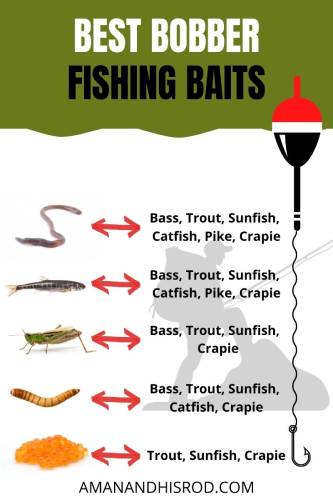
What Is A Fishing Float?
Other than being a great method of catching fish, Wikipedia defines fishing floats as; A fishing float (or bobber in the US) is an item of angling equipment.
Usually attached to a fishing line, bobbers can serve several purposes.
The advantages to using a bobber fishing setup include:
1. Fishing floats and bobbers suspend fishing bait at a predetermined depth.
2. The Buoyancy can carry the baited hook to otherwise inaccessible areas of water by allowing the float to drift in prevailing currents.
3. A fishing float serves as a visual bite indicator allowing an angler to see when a fish is eating the bait.
Fishing with a float is sometimes called float fishing.
RECOMMENDED ARTICLE >> BEST FISHING RODS UNDER $100

How To Use A Fishing Float
There are a few different methods of using a fishing float but the principle is the same with each – to suspend your bait off the bottom.
In addition, some bobbers have rattles to make noise.
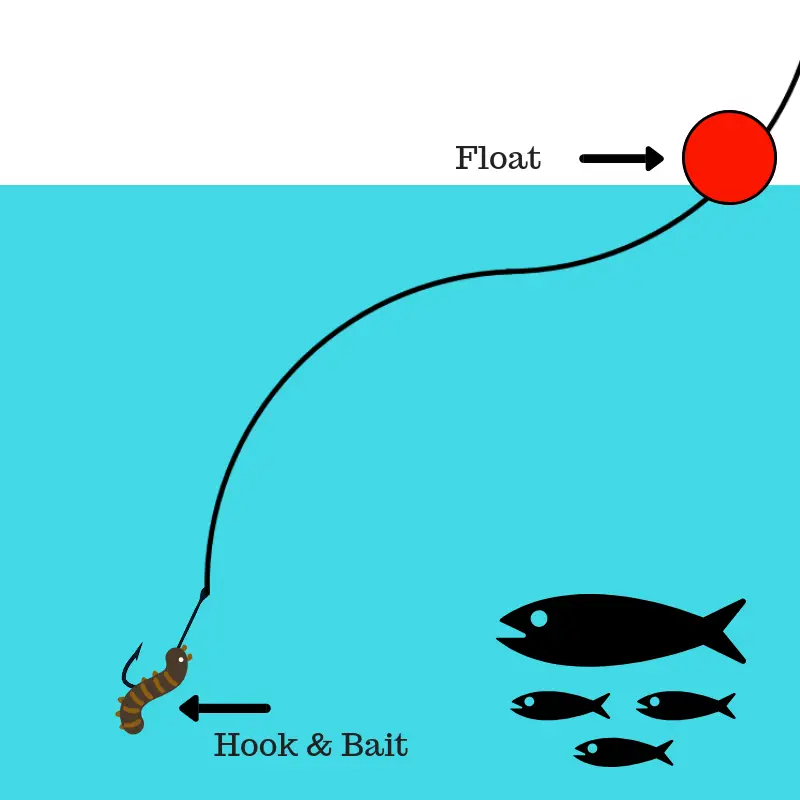
Fishing floats are a great tool to visually see a strike. Some floats allow you to fish quite deep while others are only as deep as a few feet. Either way, you will be able to visually see your bait’s location while fishing.
How to Start Bobber Fishing
1. Start by deciding what bait you will be using.
2. Depending on the bait, select an appropriate hook and attach it to the end of your line.
3. Select an appropriately sized fishing bobber. Bobber sizes vary, try to use the smallest bobber possible that will still keep your rig at the surface. Heavier baits require bigger bobbers.
4. Determine the depth at which you want to fish. Usually 2-3 feet from the hook will suffice. This is where you will attach your standard fishing bobber.
5. Attach your bobber. A standard fishing bobber has a top and a bottom. The top has a protruding piece of plastic. When you push down on the top, a small hook will emerge from the bottom of the bobber.
6. Simply place your line inside of that hook and release pressure on the top. The hook will retract and in turn grasp your line.
7. Now attach your line to the top of the bobber. This is slightly trickier. Again we have to push the top piece of the bobber down, but this time carefully place your fingers on the edges of the plastic. This will allow the hook at the top to be exposed.
8. While holding this down, place your line through the top hook and release pressure. This will allow the bobber sleeve to cover the hook and grasp your line.
9. Place your fishing bait on the hook. I like to do this last to prevent your bait from getting beat up or dislodged.
Now you are ready to make your cast. The standard Bobber sets your bait at a predetermined depth. This can be adjusted to some extent in between casts if you so wish.
Sometimes fishermen may want the bait to be fished deeper in the water column. To do this we must use a slip bobber or float.
These fishing floats make a great option for kids. They add enough weight to cast and allow a great visual indication of a strike.

Here is a less than one minute video that illustrates how to attach a bobber to your line.
What Is a Slip Bobber Fishing Float
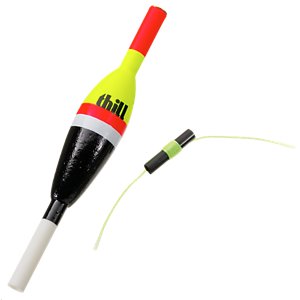
A slip bobber does just like the name implies. It slips up and down your line to a distance that is predetermined by you.
Slip floats or sliding floats are preferred when you wish to fish deeper depth with your bait.
The key is being able to determine the desired fishing depth. This will vary depending on the situation.
Once you have decided the valued depth, it’s time to attach your sliding float.
RECOMMENDED ARTICLE >> TROUT FISHING FOR BEGINNERS
How to Rig a Slip Bobber Fishing Float
At first glance rigging, a slip bobber may appear to be daunting. In reality, this is a very simple process that I will outline below.
1. Gather Materials – Start off by gathering all the materials needed for a slip bobber rig. You will need a bobber stop, the float/bobber, one or two split shot weights, your hook, and your bait. A good slip bobber will come with the float and the bobber stop.
2. Decide Depth and Attach Bobber Stop – Some stops are made to be pinched onto your line and some are made to be tied onto your line. attach the stop where you wish for the bobber to stop while sliding up your fishing line. This can also be explained as attaching the stop at the depth in which you want to fish.
EXAMPLE: If you want to fish at a depth of 20 feet, attach the bobber stop 20 feet from the hook.
3. Attach the Fishing Float – Run your line through the float. There is a hollow tube that runs the length of the float. Simply run your fishing line through that tube starting at the top of the float.
4. Attach a Fishing Hook – Select the appropriate hook and size, and attach it to the end of your fishing line.
5. Add Weight – This step is optional but I DO RECOMMEND it. This will help your bait sink to the desired depth faster and it will allow for a longer cast. Use split shot weights for this. Use one or two split shots about 2 feet above the hook. These simply pinch onto the line and are very easy to use.
6. Bait your Hook – By now you already know what bait your will be using. Simply attach the bait to the hook.
7. Casting the Slip Bobber Rig – Now comes the fun part. Cast your rig to the area you wish to fish.
8. Catch Fish! – Cast that baby out there and enjoy the fruits of your labor.
10 Expert Techniques and Tips for Successful Bobber Fishing
When it comes to bobber fishing, there are various techniques and tips that can greatly enhance your chances of success. Here are some valuable techniques and tips to keep in mind:
- Choose the Right Bait: Selecting the appropriate bait is crucial in bobber fishing. Different species of fish have different preferences, so it’s important to research and understand the feeding habits of your target fish. Whether you opt for live bait such as worms or minnows, or artificial bait like soft plastics or flies, make sure to use bait that matches the fish’s natural diet.
- Adjust the Bobber Depth: Experimenting with the depth at which your bait is suspended can make a significant difference in your catch rate. Start by setting the bobber at a depth where you believe the fish might be feeding, and then make adjustments based on the fish’s response. If you’re not getting any bites, try raising or lowering the bobber to find the sweet spot.
- Stay Patient and Observant: Successful bobber fishing requires patience and observation. Keep a close eye on your bobber for any movement, disappearance, or irregular behavior. Sometimes, fish may nibble or play with the bait before fully committing to it, so it’s essential to wait for a solid bite before setting the hook.
- Use Proper Casting Technique: To maximize your casting distance and accuracy, it’s important to use proper casting techniques. Hold the rod firmly but not too tightly, and smoothly release the line during the cast. Practice your casting skills to develop a smooth and controlled motion, allowing for precise placement of your bait.
- Be Mindful of Water Conditions: Pay attention to the water conditions as they can greatly impact fish behavior. Factors such as temperature, clarity, and current can influence where the fish are located and how actively they are feeding. Adjust your bobber depth and bait presentation accordingly to adapt to the changing conditions.
- Avoid Excessive Movement: When using bobbers, it’s essential to minimize unnecessary movement that can scare away fish. Avoid splashing or jerking the rod, as it can create vibrations in the water that may spook the fish. Practice gentle and subtle movements to keep your presentation natural and enticing.
- Fish Near Structures: Structures such as fallen trees, docks, or underwater vegetation provide shelter and hiding spots for fish. These areas can be prime fishing spots when using bobbers. Cast your bait near these structures and let the bobber drift naturally, as fish often congregate around these areas in search of food and protection.
- Vary Your Retrieve: Experiment with different retrieval techniques to entice fish to bite. You can try a slow and steady retrieve, intermittent pauses, or even small twitches to mimic the movement of injured or struggling prey. Adjust your retrieve based on the fish’s response and the prevailing fishing conditions.
- Stay Stealthy: Keep in mind that fish can be easily spooked by excessive noise and disturbances. Maintain a low profile, avoid sudden movements, and minimize noise while fishing. By being stealthy and quiet, you increase your chances of not alerting the fish to your presence.
- Practice Catch and Release: Conservation of fish populations is crucial for the sustainability of angling. Consider practicing catch and release whenever possible, especially for species that are protected or in limited supply. Handle the fish with care, using wet hands or a landing net, and release them back into the water promptly to ensure their survival.
9 Common Mistakes to Avoid When Using Bobbers
While bobber fishing can be an effective technique, there are some common mistakes that anglers often make. By being aware of these mistakes, you can avoid them and increase your chances of success. Here are some common mistakes to avoid when using bobbers:
- Using the Wrong Size Bobber: Using an improperly sized bobber can have a negative impact on your fishing experience. If the bobber is too small, it may not provide enough buoyancy to keep your bait at the desired depth. On the other hand, if the bobber is too large, it may create excessive resistance when casting or make it difficult to detect subtle bites. Choose a bobber size that matches the weight of your bait and the fishing conditions.
- Ignoring Bobber Placement: Proper bobber placement is essential for successful bobber fishing. Some anglers make the mistake of not paying enough attention to where the bobber is positioned in the water. It’s important to set the bobber at the appropriate depth where the target fish are likely to be feeding. Ignoring this aspect can result in missed opportunities and reduced catch rates.
- Setting the Hook Too Early or Too Late: Timing is crucial when setting the hook while bobber fishing. Some anglers get excited and set the hook too early at the slightest movement of the bobber, resulting in missed fish. On the other hand, waiting too long to set the hook can give the fish time to spit out the bait. It’s important to wait for a clear and strong bite before setting the hook with a swift upward motion of the rod.
- Using Excessive Weight: Adding too much weight to the line can hinder the natural movement of the bait and make it less appealing to fish. It’s important to use the appropriate amount of weight to maintain the desired depth and allow the bait to move naturally in the water. Consider adjusting the weight based on the water conditions and the behavior of the fish.
- Not Paying Attention to Line Tension: Maintaining proper line tension is crucial for detecting bites and setting the hook effectively. Some anglers make the mistake of not paying attention to the tension in their line. A slackline can make it difficult to feel bites, while excessive tension can result in premature hook sets or even breakage. Maintain a slight tension in the line and be attentive to any changes or movements.
- Lack of Patience: Bobber fishing requires patience and attentiveness. Some anglers become restless and start reeling in and recasting too frequently. It’s important to give the bait enough time to attract fish and wait for clear indications of bites. Rushing can disrupt the natural presentation and decrease your chances of success.
- Using Poor Quality Bobbers: Investing in high-quality bobbers can make a significant difference in your fishing experience. Some anglers make the mistake of using cheap or poorly constructed bobbers that may not be durable or accurately calibrated. Invest in reliable bobbers that are properly balanced and capable of providing accurate bite detection.
- Not Adapting to Changing Conditions: Fishing conditions can change throughout the day, and it’s important to adapt your approach accordingly. Some anglers make the mistake of sticking to the same bobber depth, bait, or retrieve speed without considering the changing conditions. Stay observant and be willing to make adjustments to maximize your chances of success.
- Neglecting Proper Presentation: The way you present your bait can greatly affect your success when bobber fishing. Neglecting to properly thread your bait onto the hook, using old or spoiled bait, or casting with excessive force can all result in poor presentation. Take the time to ensure your bait is presented naturally and appealingly to increase your chances of enticing fish.
By applying these techniques and tips, you can improve your success rate when bobber fishing. Remember to adapt your approach based on the specific conditions and fish species you’re targeting. Enjoy the experience, and may you reel in many memorable catches!
Conclusion – How to Use a Fishing Float or Bobber
Well, there you have it. A tutorial on how to use a fishing float/bobber. To recap, here’s a list of why we use fishing floats.
- Suspend bait in a target depth.
- Make noise to attract fish
- Adds casting distance
- Visual strike indicator
Want more great fishing content? You may also enjoy How to Catch Rainbow Trout In a Lake. An in-depth trout article designed around catching trout in lakes.
Thank you for reading this article. If you want to catch more fish you may want to read 5 Killer Trout Lures That Crush Fish.

